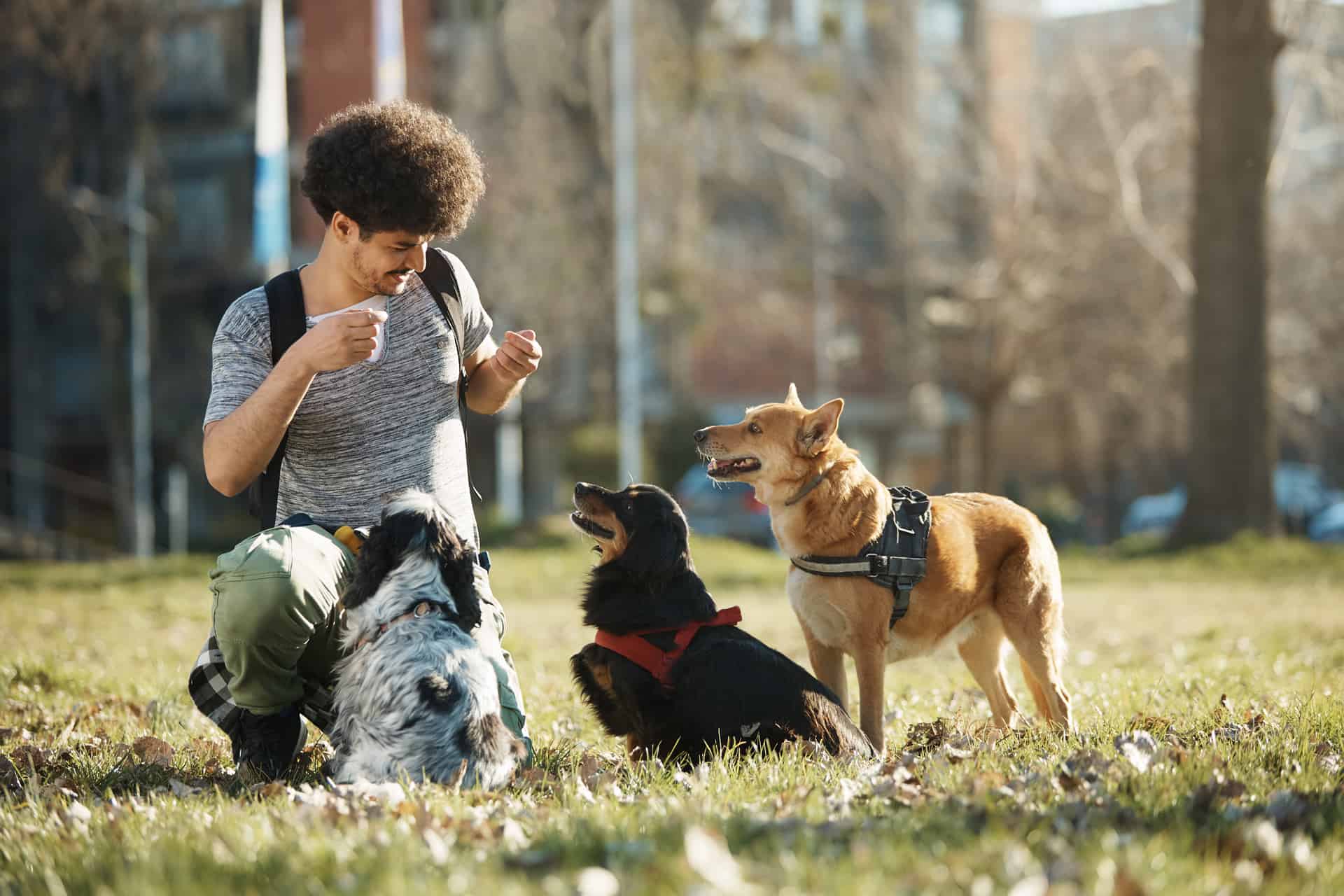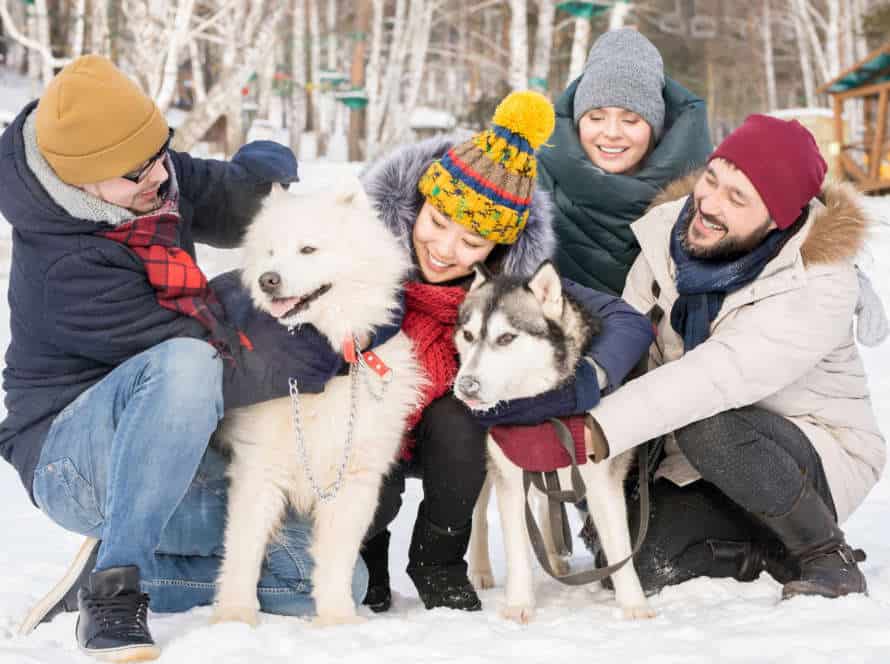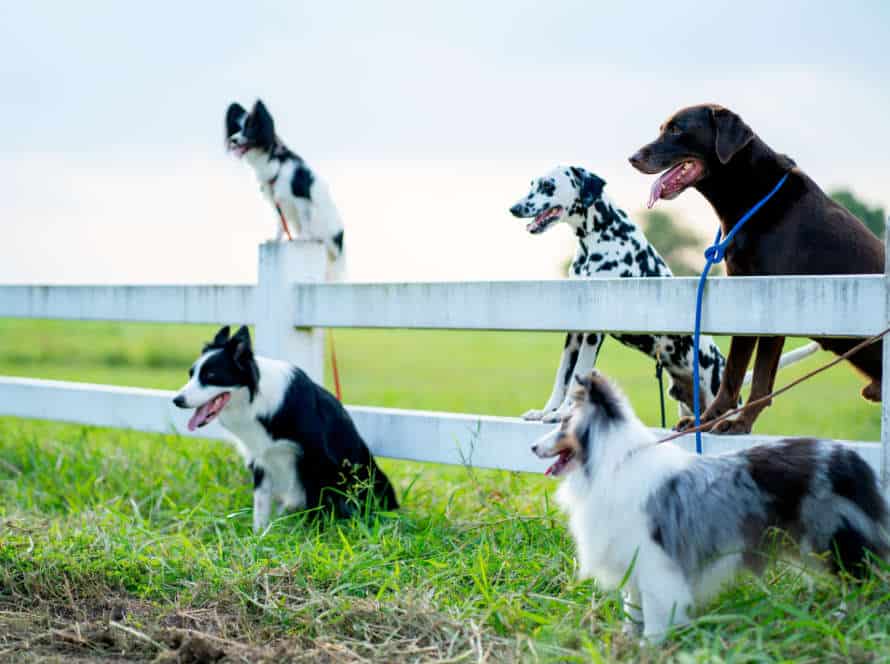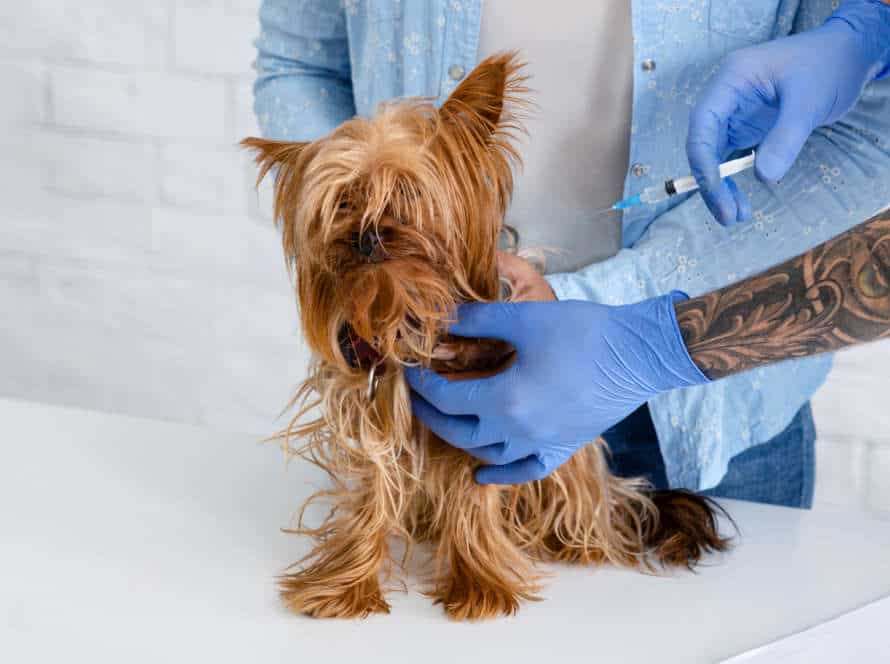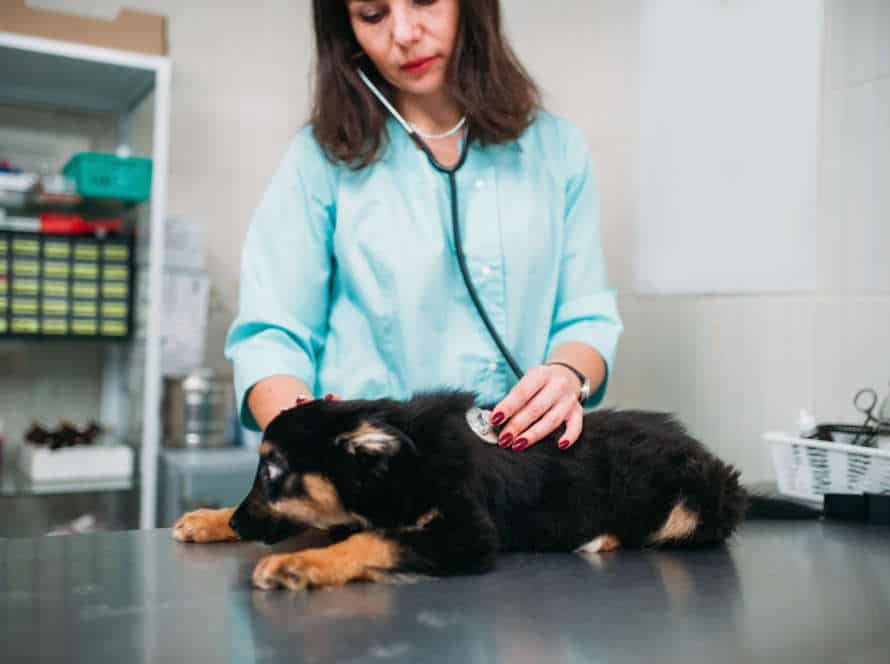Dealing with Dominant Dog Behaviors
Dealing with a dominant dog’s behavior can be tough. It’s important to know what it is, how to recognize it and how to correct it for a safe and happy home.
Signs of dominance: growling, biting, or too much barking when challenged or trying to be the leader.
Here are some tips to handle it:
- Be the pack leader by giving consistent training and setting rules and limits.
- Use positive reinforcement to encourage good behavior and discourage bad.
- Avoid aggressive or challenging training, as it can make the problem worse and hurt the dog’s trust in you.
- If the issue still exists or puts the dog and family at risk, seek help from an experienced dog trainer or behaviorist.
Dealing with dominant dog behavior needs patience, consistency, and a loving and structured environment for your pup.
Understanding Dominance in Dogs
Pups are social critters. Like us, they must have rules and limits. Knowing dominance in dogs is essential to keeping their conduct in check and a good bond with their humans. Dogs have many types of behaviors that can be seen as dominant or submissive. It’s important to know the contrast between the two, and to manage it for a balanced and healthy relationship. Let’s delve into the concept of dominance in dogs and find out how to handle it.
Definition of Dominance in the Dog Pack
Dominance in dogs is about the hierarchy within their pack or family. Dominant behaviors show that a dog thinks they are the pack leader and can control others. These behaviors can include: growling, snarling, biting, and pushing.
Knowing dominance in dogs is important. Leadership, structure, and training with positive reinforcement can help you be the pack leader and prevent dominant behaviors. To manage these behaviors you need consistency, clear communication, and setting boundaries.
If you can’t fix your dog’s dominant behaviors, get help from a professional dog trainer or behaviorist.
Signs of Dominance Behavior in Dogs
Dominance behaviour in dogs can appear in many forms. It is essential to recognize these signs to stop any potential aggression, and to have a great relationship with your dog.
Here are some common signs of dominance:
- Growling and snarling. This may be to show dominance over other dogs, or even their owners.
- Refusing orders. A dog not following your directions could be an indicator of dominance.
- Guarding resources. A dog might guard their food, toys, or even you to demonstrate dominance.
- Mounting. This behaviour could signify dominance, but also could be a sign of sexual behaviour or playing.
If you identify any of these signs, it’s important to respond. Establish yourself as the pack leader. Positive reinforcement, consistent training, and proper socialisation can help stop and repair dominance behaviour in dogs.
Causes of Dominance in Dogs
Dominance in dogs has various causes. These include poor socialization, genetics and learned behavior from their environment.
No socialization in early development can make a dog dominant. Breeds can also be prone to dominant behavior. Owners can encourage or discourage dominant behavior.
To handle dominance in dogs, become the pack leader with positive reinforcement training, consistency and a gentle approach. Exercise and playtime can help redirect the behavior.
Consistency, patience and help from a qualified trainer or behaviorist is needed to understand and manage dominance in dogs.
Prevention and Management of Dominance Behavior in Dogs
Owners of pets often battle with dominance behavior in their dogs. It can be expressed in many forms, like too much barking, mounting, guarding resources, and being aggressive. To stop, manage, or modify this behavior, it is vital to have a reliable routine and training.
Socializing Your Dog to Prevent Dominance Behavior
Socializing your pup is essential for avoiding dominance and having healthy relationships with others. Here are some tips:
- Introduce them to different people, like strangers, kids and old folks.
- Expose them to different sounds, like sirens and car horns.
- Take them to meet other dogs, both big and small.
- Reward them for good behavior and gently correct them for bad.
- Encourage playtime, bonding and interactive activities like fetch. This builds trust and lowers aggression.
Pro tip: Socialize early! Puppies between 3-14 weeks are most open to new experiences.
Establishing Yourself as the Pack Leader
Becoming the pack leader is key to controlling dominance behaviour in dogs. Dogs are pack animals that seek a leader to follow. Here are some tips for becoming the pack leader and dealing with dominant canines:
- Consistency – Be consistent with commands and expectations to establish leadership.
- Positive reinforcement – Treats and praises for good behavior.
- Confidence – Dogs take cues from you, so be confident in your body language and actions.
- Exercise – Give your dog enough exercise to release energy and diminish dominant behaviour.
- Firm but fair – Be strong when needed, but also show your dog love to build a healthy connection.
Remember, becoming the pack leader requires patience and time, however, it will help control and manage dominant conduct in dogs.
Pro Tip: Teaching your pup basic obedience commands can also help to establish you as the pack leader.
Consistency and Firmness in Training
Consistency and firmness are must-haves for training dogs. They are pack animals and need a structured routine to learn their place in the home. Here are some tips:
- Set clear and consistent rules and enforce them.
- Reward good behavior with treats, praise and play.
- No physical punishment or negative reinforcement.
- Do obedience training regularly to reinforce behavior.
- Get professional help if dominant behavior is unmanageable or aggressive. It may point to underlying issues needing treatment.
Positive Reinforcement
Positive reinforcement is an awesome way to prevent and manage dominant behavior in dogs. You can reward the pup’s good behavior and teach them what type of behavior is expected. Here are some tips to use positive reinforcement:
- Give a treat, pet or verbal praise when they do something good.
- Everyone needs to stick with the same training and rewards.
- Use rewards they like, such as small pieces of chicken, cheese or hot dog.
- Avoid punishing, it could make it worse.
Consistent use of positive reinforcement helps your pup learn what is expected and have a healthy relationship.
Dealing with Aggressive Dominance in Dogs
Dogs can be naturally dominant or learn it through bad training or environment. Any canine could show dominance, yet some breeds are more likely to put on a show of aggressive dominance. It’s essential to know how to manage a dominant dog, so it doesn’t become hazardous to its owners or other creatures. In this article, we’ll go over the most frequent sources and signs of aggressive dominance in dogs, plus how to handle it.
Assessing the Level of Aggression
Assessing aggression in a pup is key when managing dominant and aggressive acts. Here are clues to look for:
- Snarling or growling
- Biting or nipping
- Lunging or charging
- Stiff body pose
- Showing teeth
- Prolonged eye contact
- Raised fur or hair at the back
Knowing the level of aggression is essential to decide the right teaching method or if pro help is required. It’s critical to avoid encouraging dominant conduct when dealing with aggressive dogs. Redirecting their attention with positive reinforcement can help modify unwanted habits in the long run.
Pro tip: If you feel uncomfortable or unsafe with a dominant or aggressive dog, always seek expert help.
Identifying Triggers for Aggressive Behaviors
Aggressive behavior in dogs is a serious issue. It’s important to recognize the triggers for it. Common triggers are fear, territorialism, and social dominance.
Fear aggression may be triggered by loud noises or sudden movements. Territorial aggression may be due to strangers entering a dog’s space. Social dominance may cause a dog to become aggressive when feeling threatened.
To prevent aggressive behavior, identify these triggers. Take steps to avoid or manage them. Socializing your dog and training it to obey commands may be helpful. You may seek the help of a professional dog trainer or behaviorist.
Implementing Behavioral Modification Techniques
To tackle aggressive dominance in dogs or other dominant behaviors, incorporating behavioral modification techniques is a must. Here are a few that can be useful:
- Positive reinforcement – reward desired behavior with treats, praise or playtime.
- Consistency – dogs like routine, so follow the rules and training techniques.
- Redirect energy – games, training and exercise can help.
- Clear communication – use clear commands for better understanding.
- Training – obedience training builds trust and understanding.
- Seek professional help – if needed, find dog trainers.
Patience, consistency and responsible ownership can help correct dominant dog behaviors.
Seeking Professional Help
Aggressive dominance in dogs is a serious problem. Get professional help from a qualified dog trainer or behaviorist. They have the knowledge and experience to help you and your dog.
Various techniques like desensitization, counter-conditioning, positive reinforcement training, and structure and boundaries can be used.
Remember, aggression in dogs is dangerous. Professional help is the best way to resolve dominant dog behaviors and create a safe and happy home.
Dealing with Other Dominant Behaviors
Dealing with dominant behaviors in your pup? Stressful! Overwhelming! Common dominant behaviors? Growling, barking, jumping, and leash pulling. Breaking these habits? Difficult. Possible? Yes! With the right training.
Let us explore how to tackle other dominant behaviors, aside from the above.
Resource Guarding
Resource guarding is a common dominant behavior among pooches. It’s when they protect their stuff, like food, toys, and their space. Knowing how to handle it is key for living peacefully with your pet. Here are some tips:
- Teach your pup basic obedience commands and give them treats for good behavior.
- Don’t go near or take away their possessions when they are eating or playing.
- Give them treats by hand to create trust and a positive connection.
- Expose them to new people and places in a controlled way, to reduce anxiety and aggression.
- If the behavior continues, get help from a dog trainer or a vet.
Remember, resource guarding is natural and requires patience and consistency to manage.
Territory Marking
Dogs often display the behavior of territory marking – where they pee to define their space. Here’s how to manage it:
- Get them desexed: Neutering can reduce marking.
- Distract their attention: Move them away from areas they mark and to places they can do something positive.
- Keep to a schedule: Feed them, walk them, and play with them at regular times.
- Don’t scold or punish: Dogs won’t understand why they’re being punished for something instinctive. Reward good behavior instead.
Be patient with territory marking as it’s natural – and consistent with training.
Excessive Barking
Excessive barking is a dominant behavior that dogs can show. To fix it, you need to find the root cause. Boredom, anxiety, attention-seeking, and territorial behavior can all be reasons for it. Here are some ways to help:
- Exercise your dog to reduce anxiety and boredom. This may help stop the barking.
- Train them with positive techniques to replace the barking.
- Distract them with a toy or bone to chew on.
- If these don’t work, consider hiring a specialist in dealing with dominant behavior.
Pro Tip: Show calm and assertive energy when handling a dog with dominant behavior. This will make you the pack leader.
Jumping Up on People
Jumping up on people is a common dominant trait in dogs. But, you can teach them to stop this with the right training techniques. Here’s what to do:
- Train your dog to sit and practice it often.
- If they jump up on you, turn away and don’t give attention until all 4 paws are on the ground.
- Reward them for keeping all 4 paws on the ground when greeting people.
- No physical punishment or aggressive training – these will reinforce dominant behavior.
- Exercise your dog regularly to lower energy and reduce dominance needs.
- If the jumping behavior continues, get professional training or behavior modification.
Remember: consistent & positive reinforcement is key to changing your dog’s behavior!
Conclusion and Final Thoughts
Wrapping up, dealing with dominant dog behaviors can be tricky for owners. But, with the right techniques, patience, and consistency, owners can help their canines learn to be friendly, obedient, and relaxed.
Remember, even the toughest dogs can be trained and re-socialized through positive reinforcement, enough exercise, and assertive leadership techniques. It’s important to find the root of the dominant behavior, instead of just managing the symptoms. In this way, owners can tackle the issue at its core and help their dogs live happily and balanced.
Lastly, it is wise to seek professional help from dog trainers to manage dominant dog behaviors, to guarantee that your pooch gets the best care and the problem is solved correctly.
Frequently Asked Questions
Q: What are dominant dog behaviors?
A: Dominant dog behaviors refer to actions taken by a dog that demonstrate their desire for control or dominance over their owner or other dogs.
Q: How can I tell if my dog is displaying dominant behavior?
A: Some signs of dominant dog behavior include growling, snarling, and snapping during interactions with their owner or other dogs, pushing their way ahead during walks or other activities, and refusing to obey commands.
Q: What caused my dog’s dominant behavior?
A: There is no one cause of dominant dog behavior, but it is often a result of inconsistent training, a lack of socialization, or the dog feeling insecure or threatened.
Q: Can dominant dog behavior be changed?
A: Yes, dominant dog behavior can be changed through consistent training and socialization, establishing clear rules and boundaries, and working with a professional dog trainer if necessary.
Q: What should I do when my dog displays dominant behavior?
A: When your dog displays dominant behavior, it is important to remain calm and assertive, establish clear rules and boundaries, and work with a professional trainer to create a training plan that addresses the specific behavior issues.
Q: Is it possible for a dog to be too dominant?
A: Yes, excessive dominant behavior in dogs can lead to excessive aggression and other dangerous behaviors. It is important to address dominant behavior issues early on to avoid escalation.

